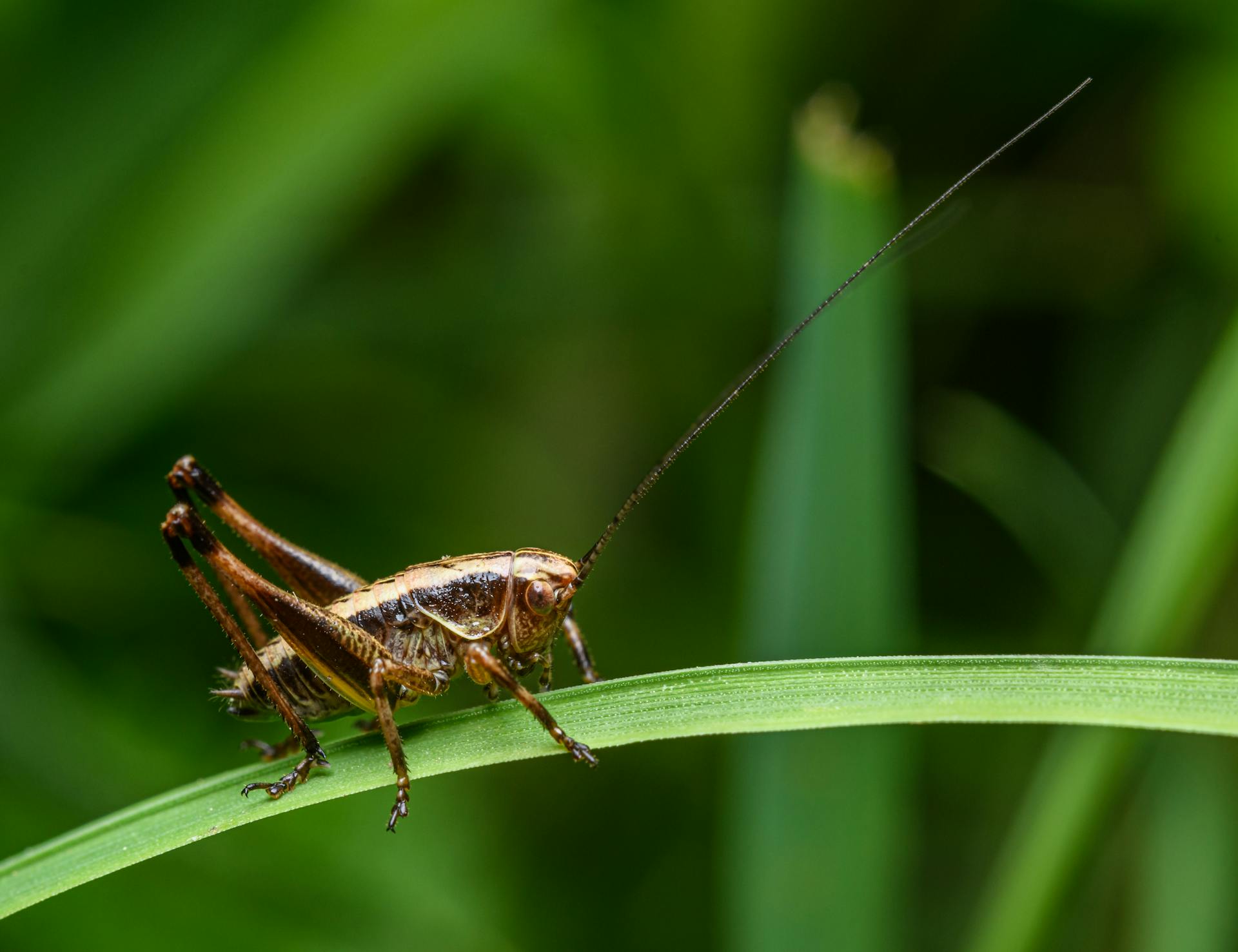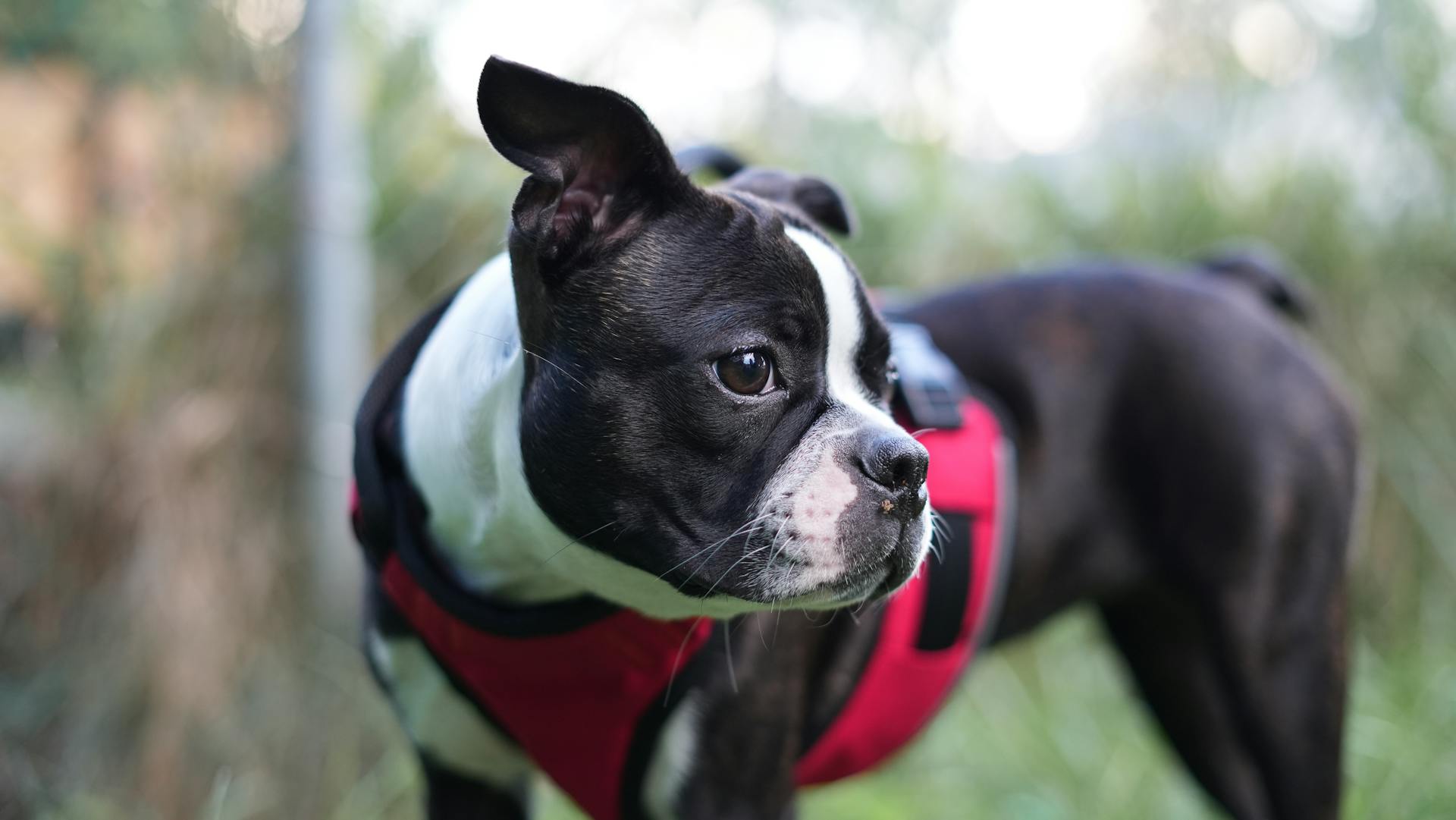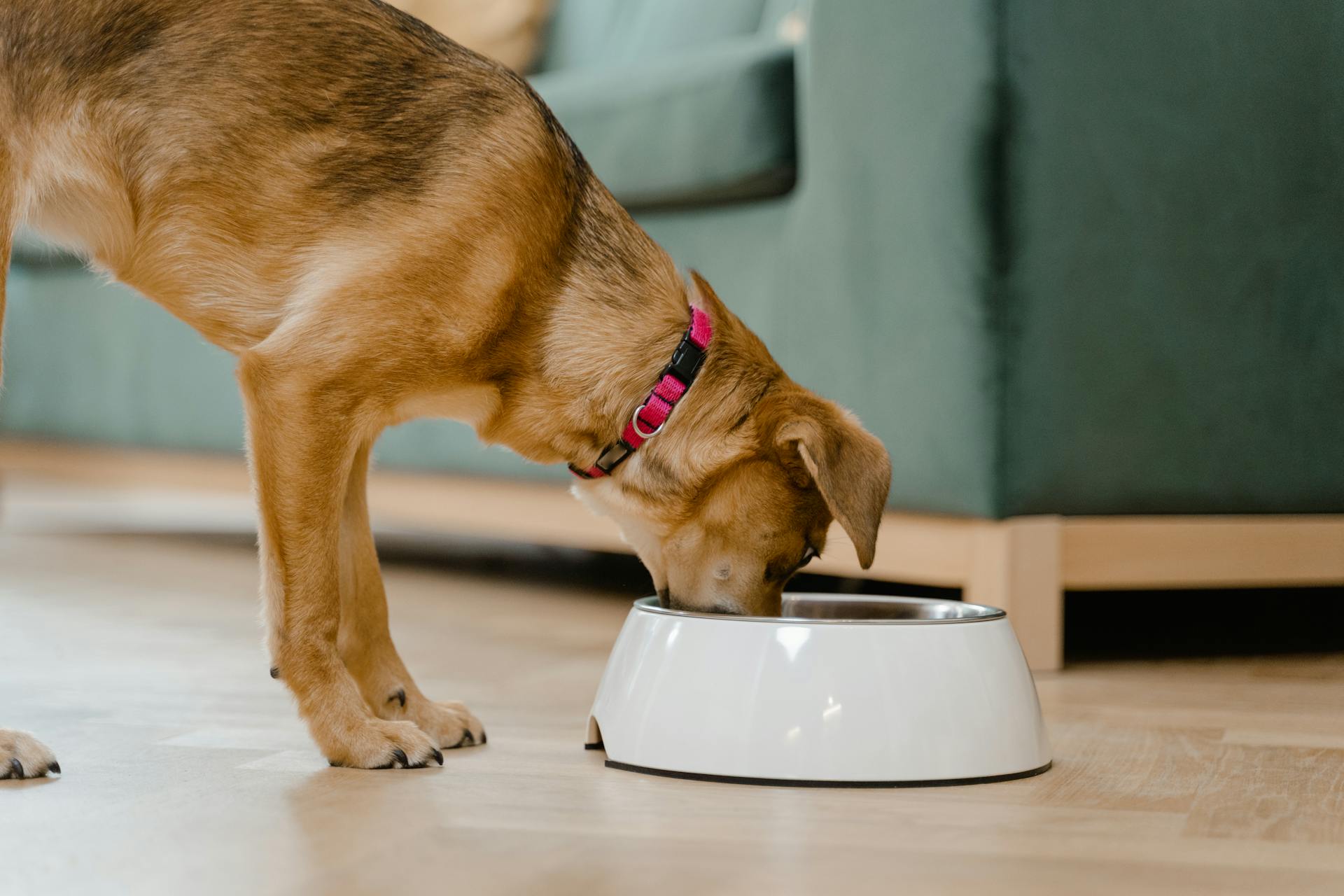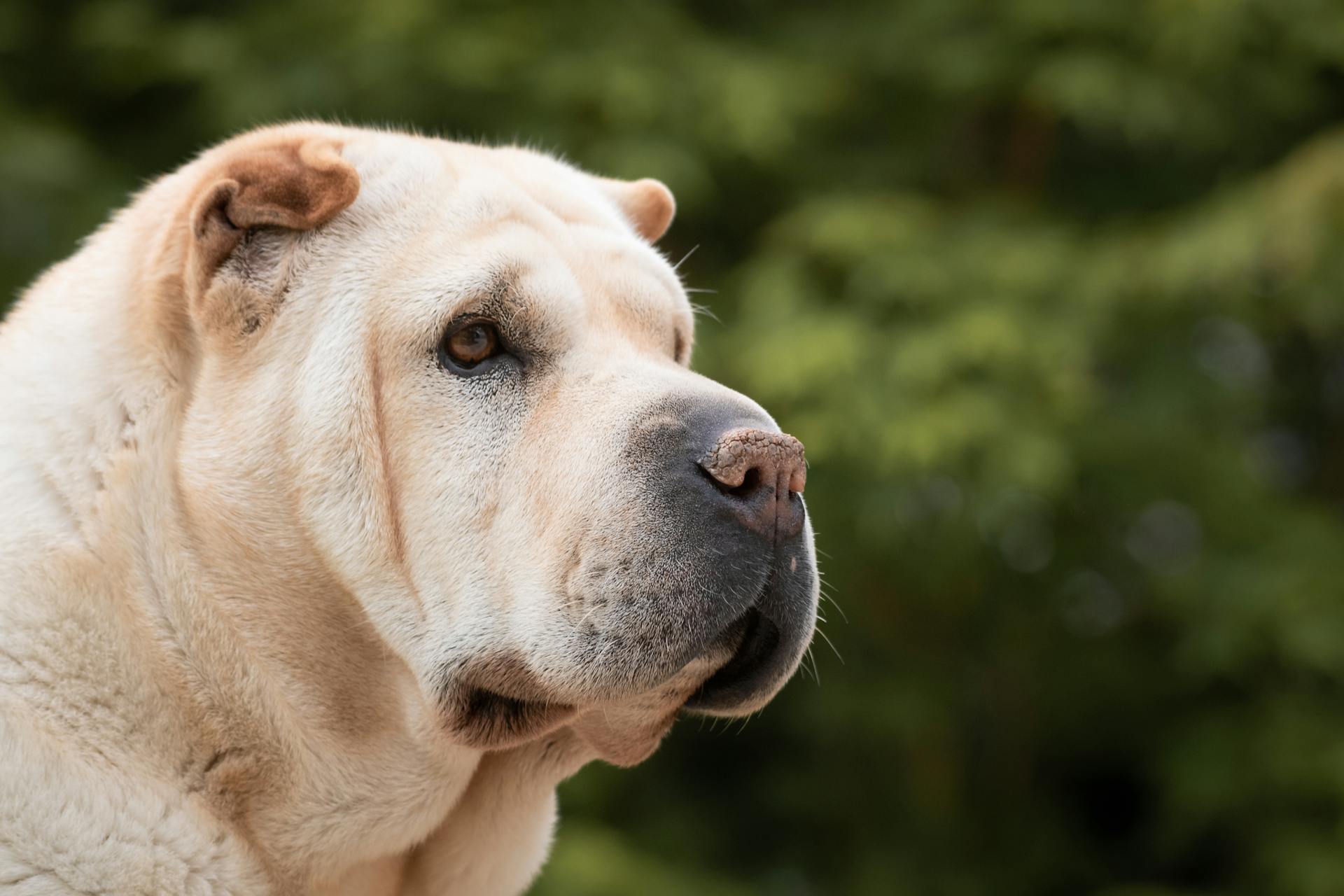
Bugs in dog treats can be a real concern for pet owners. The main causes of bugs in dog treats are contaminated ingredients, poor manufacturing practices, and inadequate quality control.
Some common culprits behind contaminated ingredients are recalled grains, proteins, and other commodities that may have been exposed to pests during transportation or storage. This can lead to a range of health issues for our furry friends.
Infestations can occur at any stage of the manufacturing process, from the initial ingredient sourcing to the final packaging. In fact, a recent recall highlighted the importance of thorough quality control measures.
By being aware of these potential causes, we can take steps to prevent bugs in dog treats and ensure our pets receive the healthy, safe snacks they deserve.
On a similar theme: Dogs Eating Bugs
Common Issues with Dog Treats
Finding bugs in dog treats is not uncommon, and it's not just a concern for homemade treats. In fact, even commercial dog treats can harbor unwanted critters. Pantry Moths, for example, are a common pest that can infest dog treats.
Sawtoothed Grain Beetles are another common pest that can be found in dog treats. These tiny beetles are attracted to the grains and starches in dog treats, and can lay eggs that hatch into larvae. Weevils, particularly flour weevils, are also a common problem in dog treats.
Here are some common pests that can infest dog treats:
Copra Beetles
Copra Beetles are a common issue with dog treats, and they're not just a nuisance, they can be a health concern for your furry friend. These tiny beetles are attracted to dried meats, fish, and even dog biscuits.
They're often shiny metallic green or blue in color and can be 3.5mm – 7mm long. If you notice any sparkly bits in your dog's food, it's best to toss the whole thing out.
Copra Beetles are persistent and will find their way to other food sources if not properly disposed of. Thorough inspection of the food's packaging and contents is essential for pest control.
If your dog accidentally swallows a few, there's no harm done, but if the infestation is severe, it can lead to more beetles being ingested, causing potential damage.
These beetles are also pretty resilient and hard to kill or squish, making them a challenge to get rid of.
Consider reading: Dog Food Aggression towards Child
Kibble
Purina's bug-based kibble contains the larvae of black soldier flies, which are intentionally added to provide extra protein and vitamins.
This kibble was first marketed in Switzerland to compete with rival brands like Insect Dog and Yora from the Green Pet Food brand. Purina Beyond Nature’s Protein kibble is a unique offering that combines field beans and chicken with bug bits.
Copra Beetles, which are often found in kibble, are known to feast on a variety of foods including cheese, fish, dried meat, eggs, fur, ham, and kibble itself. They're a bit like gym enthusiasts, obsessed with protein.
To keep your dog's kibble pest-free, it's essential to store it far away from human dry goods and consider freezing it to eliminate any unwanted critters.
Identifying and Removing Moths and Insects
Pantry Moths love to infest dry goods like grains and cereals, including dog food. This can lead to a surprise infestation, but there are steps you can take to prevent it.
To identify Pantry Moths in dog food, look for worm-like moth larvae, which are usually small and brown and can blend in with the kibble. You can also check for signs of movement by shaking the bag of dog food around a little bit.
Freezing dog food in an airtight container or large plastic bag for 72 hours can effectively kill any larvae or eggs hiding in the kibbles. This is a simple and safe way to get rid of moths in dog food.
Some common bugs in dog food include Indian Meal Moths, red-legged ham beetles, copper beetles, flour weevils, Sawtooth grain weevils, warehouse beetles, and drugstore beetles. Here's a list of these pests:
Common in Dry Environments
If you live in a dry environment, you're more likely to encounter certain pests in your dog's food. Flour Weevils are common in dry environments and can be found in dog food.
Some insects thrive in dry conditions, making them more likely to infest dog food. Red Legged Ham Beetles and Sawtoothed Grain Weevils are examples of pests that prefer dry environments.
Here are some common bugs found in dry dog food: Flour WeevilsRed Legged Ham BeetlesSawtoothed Grain WeevilsWarehouse Beetles
These pests can be difficult to remove, but taking steps to prevent infestations can be effective. Regularly inspecting your dog's food and storing it properly can help prevent infestations.
Inspect New Packages
Inspecting new packages of pet food is crucial to prevent infestations. Check all bags of dog food for signs of movement, such as larvae crawling on the tops of kibbles. Let the food settle until it's completely still, then look for signs of movement. Shake the bag gently to see if you notice anything moving. Larvae can be small and brown, and may blend in with the kibble.
If you notice larvae, it's time to toss the batch or take steps to safely kill them. Freezing the food for 72 hours can solve the problem. You can put your dog food bag in a freezer for 72 hours to kill any larvae. This may impact the flavor slightly, but most dogs don't seem to notice the difference.
If you can't return the dog food and aren't willing to chuck it in the dumpster, freezing it is a good option. Once frozen, tightly seal the lid to prevent future infestations. This will also help deter your dog from sneaking snacks between meals or chewing through the corners of your dog food bag.
Here's a list of common signs of infestation to look out for:
- Small, brown larvae crawling on the tops of kibbles
- Worm-like moth larvae
- Signs of movement or crawling on the bag or packaging
Remember to inspect all new packages of pet food as soon as you bring them home from the store. This can prevent all kinds of trouble from occurring later on down the road.
Controlling and Preventing Infestations
Pantry Moths love to infest dry goods like grains and cereals, including kibbles and animal feed. To prevent moths and other insects from getting into your dog food supply, you can take a few simple steps.
Check the bag of dog food upon receiving it for tiny holes in the packaging or other evidence of pests, and return the product to the store if you find any. This will help prevent future infestations.
Store your bag of dog kibble in a proper storage container, such as an airtight container made from metal or thick plastic. Sanitize your storage container regularly to keep it clean.
Don't stockpile your dog food, as this can attract moths and other pests. Always store pet food in a dry area, away from moisture that can lead to mold and bacteria growth.
Never use chemical pesticides on or around dog foods, as they can harm your dog if ingested. Instead, use natural deterrents like herbs and diatomaceous earth, such as bay leaves or food-grade diatomaceous earth.
Clean up after your dog is done eating, and discard leftover food to prevent attracting ants and other pests. Use a pet-safe floor cleaner to mop up any food stains.
Wash your dog's food bowl with soap and water, and rinse well to remove any residue. Consider using a stainless steel bowl, as it's easy to clean and BPA-free.
Preventing insect infestation is much easier than trying to get rid of them once they show up. If you do have an infestation, take immediate action to get rid of the bugs before the situation becomes worse.
Moth traps can help intercept adult male pantry moths, breaking the breeding cycle. You can also use natural deterrents like herbal moth-deterrent sachets filled with fragrant herbs like lavender and thyme.
Freezing the entire food bag for at least 72 hours can effectively kill eggs or larvae hidden in the dog food. Be sure to seal the dog food in a large airtight container before putting it in the freezer.
Common Household Pests and Attractants
Red-legged ham beetles, also known as Copra Beetles, are a common pest found in dog food. They're particularly attracted to dog treats and can be a nuisance to pet owners.
Sawtoothed grain weevils are another common household pest that infests dog food, especially dry dog food. These tiny insects can be found in a variety of pet food products, including dog treats.
Flour weevils are a type of pantry pest that can infest dog food, particularly dog treats made with flour or grain-based ingredients. They're often found in small, enclosed areas like pantries or cupboards.
Indian Meal Moths are a common pest found in dog food, including dog treats. Their larvae can be found in the food, causing damage and making it unpalatable for pets.
Drugstore beetles, also known as cigarette beetles, are a common pest found in dog food, particularly dry dog food. They're attracted to the ingredients in dog treats and can be a nuisance to pet owners.
Here are some common household pests and attractants that can infest dog food:
- Red-legged ham beetles (Copra Beetles)
- Sawtoothed grain weevils
- Flour weevils
- Indian Meal Moths
- Drugstore beetles (cigarette beetles)
Cockroaches and mice are also attracted to dog food and can infest dog treats. They're often found in areas with poor sanitation and can be a health risk to pets and humans.
Warehouse beetles and pantry moths are other common pests that can infest dog food, particularly dry dog food. They're attracted to the ingredients in dog treats and can cause damage and make the food unpalatable for pets.
Specific Treat-Related Issues
If you've discovered bugs in your dog's treat, it's essential to stop feeding it immediately.
Feeding compromised food can lead to health issues in your dog.
Watch your dog for signs of infestation, such as vomiting, diarrhea, or excessive scratching. If these signs persist, contact a vet promptly.
Even with a good safeguard like a flea preventative, bugs in dog food can still cause issues.
A fresh viewpoint: Types of Dog Bugs
List of Common
If you've ever noticed weird insects crawling around in your pet's bag of food, you're not alone. In fact, it's quite common for pet owners to discover unwanted critters in their pet's food.

The most common bugs found in dog food are Indian Meal Moths, red-legged ham beetles, copper beetles, flour weevils, Sawtooth grain weevils, warehouse beetles, and drugstore beetles.
These pests can infest pet food when they're not properly sealed or stored, allowing them to crawl in and make themselves at home. Pantry Moths, in particular, are notorious for infesting pet food.
Here's a list of the most common pests that infest pet foods:
- Pantry Moth (Indian Meal Moth)
- Sawtoothed Grain Beetle
- Weevils (Flour Weevils, particularly)
- Drugstore Beetles, Warehouse Beetles, Red Legged Ham Beetles
- Mice, Cockroaches, and Other Scavengers
It's worth noting that some of these pests can lay eggs in the food, which can hatch into larvae that are difficult to spot. Regularly inspecting your pet's food for signs of infestation can help prevent this from happening.
Purina Kibble
Purina Beyond Nature’s Protein kibble is infused with the larvae of black soldier flies, which are a good source of protein and vitamins for dogs.
This kibble was first marketed in Switzerland to compete with rival brands.
The kibble also contains field beans and chicken, making it a nutritious option for dogs.
Interestingly, cat kibble from the same sub-brand has no bugs in it, only chicken, pork, and millet.
The black soldier fly larvae are a deliberate addition to the kibble, not an accidental contaminant like in other cases.
Copra Beetles, which are mentioned as an example of bugs that can infest food, are known to feast on cheese, fish, dried meat, eggs, fur, ham, and kibble.
Two Responses
If you've discovered bugs or larvae in your dog's food, stop feeding it immediately to prevent further infestation.
It's normal for dogs to scratch if their food is infested, and some owners may even experience itchiness themselves.
Vomiting and diarrhea are possible signs that your dog's infestation is linked to the compromised food, so monitor your dog closely and contact a vet if these symptoms persist.
General Information and Tips
When choosing dog treats, it's essential to check the ingredient list for potential allergens like peanut butter and eggs.
Some dog breeds are more prone to food allergies than others, such as Labradors and German Shepherds.
Always store dog treats in a cool, dry place to prevent mold growth, as seen in some recalled treats.
The FDA has issued recalls for dog treats contaminated with Salmonella and E. coli, highlighting the importance of proper storage.
Dogs with sensitive stomachs may benefit from treats made with novel protein sources like venison or duck.
Treats containing artificial preservatives can be detrimental to a dog's health, so opt for natural preservatives whenever possible.
Some dog treats are made with whole food ingredients, such as fruits and vegetables, which can be beneficial for a dog's digestive health.
Curious to learn more? Check out: What Are in Dog Treats
Sources
- https://www.kohepets.com.sg/blogs/articles/bugs-in-dog-food
- https://www.moth-prevention.com/blogs/the-art-of-prevention/moths-in-dog-food
- https://www.bugsdefender.com/dog-food-bugs/
- https://gooddogpeople.com/blogs/dog-talk/how-to-get-rid-of-bugs-in-dog-food
- https://alluneedpest.com/bugs-in-your-dog-food-what-could-they-be/
Featured Images: pexels.com


